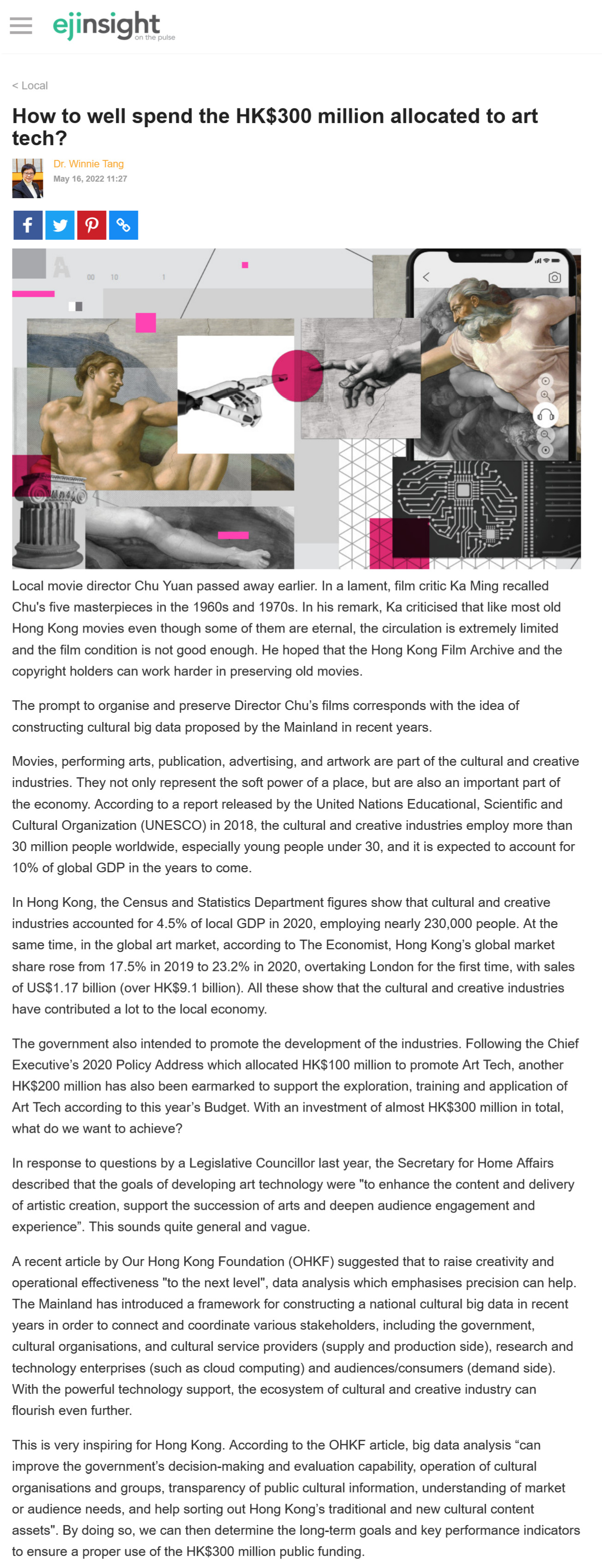網上版請按此

How to well spend the HK$300 million allocated to art tech?
Local movie director Chu Yuan passed away earlier. In a lament, film critic Ka Ming recalled Chu's five masterpieces in the 1960s and 1970s. In his remark, Ka criticised that like most old Hong Kong movies even though some of them are eternal, the circulation is extremely limited and the film condition is not good enough. He hoped that the Hong Kong Film Archive and the copyright holders can work harder in preserving old movies.
The prompt to organise and preserve Director Chu's films corresponds with the idea of constructing cultural big data proposed by the Mainland in recent years.
Movies, performing arts, publication, advertising, and artwork are part of the cultural and creative industries. They not only represent the soft power of a place, but are also an important part of the economy. According to a report released by the United Nations Educational, Scientific and Cultural Organization (UNESCO) in 2018, the cultural and creative industries employ more than 30 million people worldwide, especially young people under 30, and it is expected to account for 10% of global GDP in the years to come.
In Hong Kong, the Census and Statistics Department figures show that cultural and creative industries accounted for 4.5% of local GDP in 2020, employing nearly 230,000 people. At the same time, in the global art market, according to The Economist, Hong Kong's global market share rose from 17.5% in 2019 to 23.2% in 2020, overtaking London for the first time, with sales of US$1.17 billion (over HK$9.1 billion). All these show that the cultural and creative industries have contributed a lot to the local economy.
The government also intended to promote the development of the industries. Following the Chief Executive's 2020 Policy Address which allocated HK$100 million to promote Art Tech, another HK$200 million has also been earmarked to support the exploration, training and application of Art Tech according to this year's Budget. With an investment of almost HK$300 million in total, what do we want to achieve?
In response to questions by a Legislative Councillor last year, the Secretary for Home Affairs described that the goals of developing art technology were "to enhance the content and delivery of artistic creation, support the succession of arts and deepen audience engagement and experience". This sounds quite general and vague.
A recent article by Our Hong Kong Foundation (OHKF) suggested that to raise creativity and operational effectiveness "to the next level", data analysis which emphasises precision can help. The Mainland has introduced a framework for constructing a national cultural big data in recent years in order to connect and coordinate various stakeholders, including the government, cultural organisations, and cultural service providers (supply and production side), research and technology enterprises (such as cloud computing) and audiences/consumers (demand side). With the powerful technology support, the ecosystem of cultural and creative industry can flourish even further.
This is very inspiring for Hong Kong. According to the OHKF article, big data analysis "can improve the government's decision-making and evaluation capability, operation of cultural organisations and groups, transparency of public cultural information, understanding of market or audience needs, and help sorting out Hong Kong's traditional and new cultural content assets". By doing so, we can then determine the long-term goals and key performance indicators to ensure a proper use of the HK$300 million public funding.
Dr. Winnie Tang
Adjunct Professor, Department of Computer Science, Faculty of Engineering; Department of Geography, Faculty of Social Sciences; and Faculty of Architecture, The University of Hong Kong